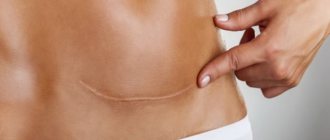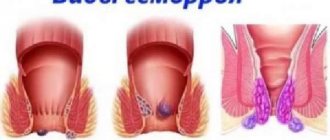Constipation after any delivery is a common problem. Delayed emptying may be associated with hormonal changes in the body, weakening of intra-abdominal pressure, muscle weakness, and decreased intestinal motility. Often the problem of constipation continues from pregnancy itself: the growing uterus mechanically compresses the intestines, fluid retention also contributes to stagnation of feces.
However, with surgical delivery - caesarean section - others are added to the list of mechanisms for the development of constipation. In this article we will figure out what causes constipation during a caesarean section and how to deal with it.
Causes of constipation after cesarean section
Many young mothers are interested in knowing why constipation occurs after a cesarean section. Several mechanisms for the development of defecation retention are described:
- Preoperative preparation. If the delivery operation is planned, refusal to eat a few hours before the intervention is provided. This may affect intestinal motility.
- Anesthesia. Both epidural anesthesia and general anesthesia can affect digestive function.
- Presence of a postoperative wound. Any surgical intervention can lead to subsequent constipation during the rehabilitation period. In addition, a young mother often experiences fear of defecation due to the presence of a suture and deliberately postpones going to the toilet.
Stress and changes in psycho-emotional state can also affect intestinal function. Blood loss as a result of surgery and early postpartum hemorrhage, vitamin and mineral deficiencies after a difficult pregnancy are all possible causes of constipation.
Let's look at why constipation develops after a cesarean section. There are quite a few reasons, here are the main ones briefly:
- Preoperative preparation: cleansing enema or laxatives on the eve of the intervention, the need to fast for several hours before surgery.
- Antibacterial therapy: necessary to prevent postoperative complications, for example, infection of the wound surface. Despite the fact that antibiotics approved for lactation will be selected for the young mother, they can cause the development of intestinal dysbiosis.
- Changing the position of internal organs: contraction of the uterus leads to the fact that both intestinal loops and tissues begin to gradually return to their normal position. Such changes may be accompanied by delayed bowel movements.
- Effect of anesthesia: anesthesia for caesarean section is used quite rarely and according to strict indications. However, even epidural anesthesia involves the administration of medications that affect intestinal motility.
- Effect of painkillers: in the postoperative period, analgesics, antispasmodics and other drugs are often used to help relieve pain. They affect intestinal motility, leading to constipation.
- Effect of other medications: in some cases, after a cesarean section, specific treatment is required. Normal practice after delivery is for the doctor to change the treatment regimen for chronic diseases and supplement therapy with drugs that were contraindicated during pregnancy. They can indirectly affect bowel function. For example, some drugs stimulate diuresis, others promote relaxation of smooth muscles, etc.
- Traumatic factors: any operation is perceived by the body as an injury. As a result, physiologically active substances are produced, which also affect the processes of bowel movement.
Despite the variety of possible causes of constipation in a woman in labor, the main ones are still considered to be changes in peristaltic activity and intestinal position, as well as the use of antibiotics and painkillers.
After planned and emergency caesarean section, a course of preventive antibiotic therapy is prescribed. Antibiotics provoke a change in the balance of intestinal microflora, resulting in constipation.
There is no need to refuse treatment. It is important to tell your doctor about your problem, and he will choose the best solution. There is no need to wait for the symptom to go away on its own. Constipation after a cesarean section can weaken the mother's body's defenses, lead to complications and intoxication, and even harm the baby if the mother is breastfeeding: toxic substances that accumulate in the body due to delayed bowel movements enter breast milk.
If we are talking about severe constipation after a cesarean section several weeks after the operation, then the source of the problem may be the diet. Some mothers, while caring for their baby, forget about proper nutrition. Eating snacks, fast food and processed foods, irregular meals, and overeating on carbohydrates - all this can lead to intestinal dysfunction.
Get rid of intestinal problems
The natural British drug is not addictive and works immediately
Find Phytomucil with benefits
How is a caesarean section different from a normal birth?
Caesarean section is considered less traumatic and has a higher percentage of positive outcomes than natural childbirth, when, for example, a woman may die due to blood loss.
Caesarean also eliminates perineal ruptures and lasts about 45 minutes, while natural childbirth can last 12 hours or more. Due to the fact that during a caesarean section the woman does not have to push too hard, the risk of birth injuries to the baby is reduced.
The negative aspects include:
- risk of complications;
- long recovery period;
- the negative impact of anesthesia on both the woman and the baby.
If a woman does not have specific indications for surgical intervention, then, of course, the best option for her would be to go through a natural birth.
When passing through the birth canal, the child passes his first obstacle, which will benefit him, and for the development of the reproductive system, it is important for girls to receive a portion of the mother’s microflora, which can only happen during normal childbirth.
There is a recovery period for both cesarean and natural childbirth, the only difference is the time it takes for the woman to recover. With caesarean, the rehabilitation process still lasts longer and there are reasons for this: blood loss, surgical intervention.
Symptoms of constipation after cesarean section
Constipation can develop immediately after a cesarean section or some time later. Symptoms usually appear within the first week after the intervention. The main symptoms of constipation include the following:
- lack of stool for two days in a row or more;
- pain during bowel movements;
- the need to strain;
- fragmented, dense stool;
- small volume of feces;
- flatulence, rumbling in the stomach;
- feeling of heaviness and pressure in the abdomen, rectum;
- pain in the lower abdomen.
In some cases, there is a rise in body temperature, which is associated with both constipation and its cause - a recent operation.
Signs of a problem developing
As already mentioned, the cause of this problem is usually an incorrectly formulated and irregular diet. But if problems with bowel movements are accompanied by additional manifestations, then nutrition has nothing to do with it at all. Such signs include the absence of bowel movements for 2 or more days. Confirms the pathological etiology of constipation and discomfort in the left peritoneum or its cavity as a whole, flatulence, a feeling of fullness and distension of the intestinal structures.
A sign of serious constipation is pain and other difficulties with bowel movements such as too small or too large portions, etc. Belching, lack of appetite, nausea attacks, apathy and fatigue, irritability, soreness of the anus, cracks and bleeding from the anus - all this indicates a complex origin intestinal problem.
The clinical picture of constipation is determined by its form, of which there are 2 types: atonic and spastic. Atonic constipation is most typical for cesarean section. They have a rare desire to defecate. Feces stagnate in the intestinal structures and harden, which is why subsequent release is accompanied by intense pain. Spastic constipation has psychological reasons for its development and is caused by the presence of intestinal bowel movements before the upcoming one. The patient feels that if she strains, she may damage the postoperative sutures. Therefore, when you want to empty your bowels, spontaneous contraction of the sphincter occurs.
Complications due to constipation
An early complication of constipation after cesarean section is lactation disturbance. This is due to intoxication of the body, lack of nutrients, and pain experienced by the mother. In the long term, regular defecation delays can lead to complications such as:
- dysbacteriosis;
- deficiency of vitamins and minerals;
- disruption of tissue regeneration processes;
- high incidence of ARVI, decreased body resistance to infections.
Pregnancy is a risk factor for the development of hemorrhoids, and subsequent constipation aggravates the situation. The likelihood of the formation of inflamed hemorrhoids and anal fissures increases.
As the problem worsens, deformations of the intestinal walls and inflammatory processes often occur. Chronic constipation is known to increase the risk of colorectal cancer.
One of the serious complications is the appearance of fecal stones. These are dense masses that cause obstruction. This condition requires surgery.
Preliminary diagnosis
The doctor needs to make sure that constipation is not caused by diseases of the digestive system or dangerous conditions. Some gastrointestinal pathologies may be rare complications of cesarean section. During the consultation, the doctor asks about symptoms, reviews your medical history to identify risk factors, and performs a physical examination.
To identify the possible cause of constipation, instrumental and laboratory diagnostics may be required. Additional research:
- Blood test for thyroid hormones.
- Sigmoidoscopy is an endoscopic examination of the rectum and large intestine. The doctor inserts a flexible tube equipped with a camera and a light source into the intestinal cavity to identify structural pathologies.
- Additional tools also allow you to evaluate the function of the sphincter muscles.
- Diagnosis of gastrointestinal tract patency. The patient is given a special capsule containing contrast markers. After swallowing the capsule, the doctor performs a scan to assess the patency of the organs.
- Computed tomography and magnetic resonance imaging are methods of scanning organs that allow obtaining high-resolution images.
Most often, such complex and rather unpleasant diagnostic procedures are not required. Women already endure many unpleasant medical procedures during childbirth. However, if specific signs are present, the doctor may prescribe additional diagnostics.
Features of treatment
Your doctor will tell you what to do if you have constipation after a cesarean section. The first recommendation is to take a laxative. It is important to quickly deal with the problem and prevent severe intoxication. The choice of drug should be based on factors such as health status, individual characteristics, causes of constipation, and the presence or absence of lactation.
There are products that are approved for use during breastfeeding. One of these drugs is the English biocomplex “Fitomucil Norm”. It has an absolutely natural composition and contains no preservatives or dyes. "Fitomucil Norm" contains the pulp of plum fruits and the shell of plantain seeds. Natural plant fibers absorb water. The product turns into a mucous gel, resulting in a gentle and comfortable removal of stagnant feces.
The drug stimulates intestinal motility without spasms and bloating, is not addictive, and acts painlessly. It has no side effects and is approved for long-term use. In addition, the drug stimulates the growth of beneficial microflora, which contributes to the long-term prevention of constipation.
Medications to combat stool disorders
Not all medications for the treatment of constipation can be used by nursing mothers. Consulting with a specialist will help you make the right choice.
Duphalac
The drug contains lactulose. Pharmacological form of release: syrup. The drug is safe for mother and baby. It is worth remembering: the properties of the medication are ensured by compliance with the correct administration. Duphalac is prescribed by a doctor, who also determines the dose and frequency of administration. The active ingredient acts only inside the mother’s intestines, without being absorbed into the blood. Thanks to this, the drug does not pass into the milk and does not reach the baby.
The action of the medication is aimed at attracting moisture into the intestinal canals. A laxative effect occurs. Under the influence of acids, into which lactulose breaks down in the digestive tract, an increase in feces occurs and intraintestinal pressure increases. What happens promotes a natural way to get rid of feces, bringing it out without pain and additional tension in the abdominal muscles.
Fortrans
Available in powder for the preparation of suspensions. The active ingredient is macrogol 4000. It is located in the digestive tract and acts exclusively locally. It is not absorbed into the bloodstream and does not pass into the baby's milk. Safe for babies. In the colon, it increases the volume of fecal matter, making it elastic and soft. Pressure is created, pushing the stool out.
Ferrolax
Pharmacological form of release: rectal suppositories. The drug provokes excessive gas formation in the intestines, thereby eliminating the symptoms of spastic disorder. The spasmodic phenomenon disappears, the patency of the canal increases, and the contents leave the organ.
Glycelax
Glycerin suppositories are indispensable for the treatment of constipation resulting from cesarean section. They have a simultaneous effect on intestinal motor function and help stool become softer. The process of emptying is easy, without pain. Using suppositories: 1 suppository is inserted through the anus into the rectum the morning after a meal. They try to push the candle deeper into the intestines, about an outstretched finger.
Diet
Following a diet will help you cope with severe constipation after a cesarean section. Don't forget to drink enough fluids, especially during lactation. Consult your doctor about which foods you should definitely include in your daily diet. Some of them have a laxative effect, these include:
- dried apricots, prunes;
- fresh vegetables and fruits;
- bran;
- fresh berries;
- wholemeal bread;
- dairy products.
Herbal teas based on rosehip, cumin, and dill also have a laxative effect. It is important to agree on a new diet with your doctor, taking into account possible allergic reactions, if you want to maintain lactation.
ethnoscience
The public pharmacy will stock the necessary medications to treat constipation resulting from a caesarean section. In this case, the drugs act only on the colon, without affecting breast milk.
Figs
A decoction is made from the fruit. The berries are pre-chopped. 2 tbsp. pour a glass of milk or water. Keep on low heat (20 minutes). Drink the decoction throughout the day, before meals. Taking 1 tablespoon of the drug helps the intestines perform their functions.
Herbal mixture
The main components are valerian, anise, nettle. The mixture includes strawberries and chamomile. The ingredients are mixed and placed in a thermos. Pour a glass of boiling water. The broth is infused for 2 hours. You need to drink the entire amount at once. Helps well with spastic constipation.
Fennel, anise and cumin
An infusion of medicinal herbs is made as follows. The same amount of each medicine is poured with hot water and infused in a thermos. After drinking throughout the day. Divide the volume into three equal parts.
Ways to restore intestinal activity
To begin with, at the first signs of constipation, mom can try to solve the problem on her own. If you can’t cope with constipation, you will have to seek medical help, otherwise the body will suffer seriously due to the toxic effects. Constant worry and discomfort in the intestines, painful sensations in the abdomen - all this steadily leads to a complete cessation of lactation and a worsening of the overall picture of the condition. To restore full intestinal activity, traditional medications, nutritional correction and home tricks can be used.
Traditional medicine
The approach to treatment with traditional medications requires careful attention when prescribing drugs to lactating women, because not all of them are approved for use. In general, the following medications are prescribed:
- Fortrans or Forlax. Powder for the preparation of a drinking solution with the main active ingredient in the form of macrogol. The drug liquefies fecal deposits and promotes their natural release. Take in a dosage of 1 sachet per day.
- Duphalac, Normaze, Portalac. These are drugs containing a lactulose component that stimulate intestinal activity, soften and remove feces along with toxins. You need to take this drug in a dosage of 1-3 sachets per day.
If a woman does not breastfeed her baby, then medications such as Gutalax, Regulax, Dr. Theiss or Bisacodyl can be used for treatment. You can also use rectal suppositories like Glycelax, suppositories with sea buckthorn, Calciolax or Ferrolax to treat stool. Suppositories are administered daily, following the instructions. The main thing is not to overdo it, strictly following the recommended dosages, otherwise constipation can gradually turn into diarrhea, which is also a rather unpleasant condition.
Nutrition
During the postpartum recovery process, it is important to follow the principles of special dietary nutrition, which will help normalize all organic functions. Such a diet involves eating foods enriched with fiber, for example, steamed vegetables, bran bread, dietary meat or dairy products. Water-based liquid porridges, kefir, oven-baked apples - all this should be eaten more often. Olive oil also has a laxative effect. But fried foods and white bread should be avoided.
Home methods
There are many methods against constipation, which are based on the knowledge of traditional medicine. Decoctions of figs or mixtures of cumin, anise and fennel have a laxative effect. Also helping to cope with constipation is a herbal mixture of components such as chamomile flowers and strawberries, mint and anise, and nettle leaves. But without fanaticism. You should definitely discuss the prescription with your doctor, because everything you eat or drink will enter your baby’s body. When the seam heals and stops getting wet, you can perform a special massage for the abdominal area.










